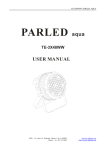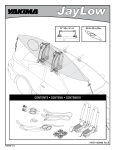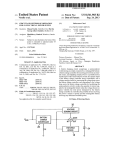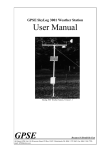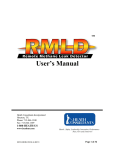Download GTA-4100R - Fixed Gas Detectors, Portable Gas Detectors, Flame
Transcript
GTA‐4100R Dual Processor, Dual Channel Controller Card Part Number 73‐4100R Manual Revision v6.30 (updated 10 November 2009) Table of Contents 1 2 Introduction ................................................................................................................................................... 6 1.1 Features ................................................................................................................................................ 6 1.2 Front Panel Layout ................................................................................................................................ 7 Installation ..................................................................................................................................................... 8 2.1 Mounting............................................................................................................................................... 9 2.1.1 Micro RackTM ..................................................................................................................................... 9 2.1.2 Standard 19” Rack............................................................................................................................. 9 2.2 Wiring.................................................................................................................................................. 10 2.2.1 3 Common Module ............................................................................................................................ 11 Configuration ............................................................................................................................................... 14 3.1 Isolate Mode ....................................................................................................................................... 14 3.2 Configuration & Programming ............................................................................................................ 15 3.2.1 Board Layout................................................................................................................................... 16 3.2.2 Extender Card ............................................................................................................................... 167 3.2.3 Output Power Supply...................................................................................................................... 17 3.2.4 Sensor Voltages .............................................................................................................................. 18 3.2.5 Relay Configuration ........................................................................................................................ 20 3.2.6 Switch Bank 1.................................................................................................................................. 21 3.2.7 Switch Bank 2.................................................................................................................................. 22 3.2.8 Setting the Range............................................................................................................................ 23 3.2.9 Setting the Units of Measurement ................................................................................................. 25 3.2.10 Setting Alarms................................................................................................................................. 26 3.2.11 Gain and Offset Settings ................................................................................................................. 27 3.3 Settings Summary Table...................................................................................................................... 28 3.4 Configuration Examples ...................................................................................................................... 30 3.4.1 Catalytic Sensor .............................................................................................................................. 30 3.4.2 Two‐wire 4‐20mA Loop Powered Sensor & Transmitter ................................................................ 30 3.4.3 Three‐wire 4‐20mA Sensor & Transmitter (500mA Max)............................................................... 31 3.4.4 Three‐wire 4‐20mA Sensor & Transmitter (500mA Min) ............................................................... 31 3.4.5 Digital Contact Open & Closed (Callpoints) .................................................................................... 32 3.4.6 Smoke & Heat Detectors ................................................................................................................ 32 3.4.7 Externally Powered Activate Devices.............................................................................................. 33 3.5 4 Calibration........................................................................................................................................... 34 General Use.................................................................................................................................................. 35 4.1 Checks ................................................................................................................................................. 35 4.2 Alarms ................................................................................................................................................. 36 4.2.1 Low AL1 Alarm ................................................................................................................................ 36 4.2.2 High AL2 Alarm ............................................................................................................................... 37 4.2.3 Ack/Rest Button.............................................................................................................................. 37 4.2.4 Fault Alarm...................................................................................................................................... 37 4.3 Normal Operation ............................................................................................................................... 38 4.4 Maintenance ....................................................................................................................................... 38 APPENDIX I. Troubleshooting ......................................................................................................................... 39 APPENDIX II. Spare Parts List ........................................................................................................................... 40 4.5 Power Supplies.................................................................................................................................... 40 APPENDIX III. Specifications.............................................................................................................................. 41 Page ii © 2008 GasTech Australia Pty Ltd PROPRIETARY STATEMENT GasTech Australia owns proprietary rights in the information disclosed within. By receiving this document, the recipient agrees that neither this document nor the information disclosed within nor any part shall be reproduced or transferred to other documents or used or disclosed to others for manufacturing or for any other purpose except as specifically authorised in writing by GasTech Australia. COPYRIGHT STATEMENT Information contained in this document is protected by copyright. No part of this document may be photocopied, reproduced, or translated to another program or system without prior written authorisation from GasTech Australia. TRADEMARK STATEMENT Protected through use and/or registration in the United States and many foreign countries are the trademarks and service marks of GasTech Australia. The use of the ® symbol indicates registration in the United States only and the “TM” is in Australia; registrations may not have been issued at present in other countries. All other product names and logos are trademarks of their respective owners. DISCLAIMER Under no circumstances will GasTech Australia be liable for any claims, losses, or damages resulting from or arising out of the repair or modification of the equipment by a party other than GasTech Australia or its authorised service representatives, or by operation or use of the equipment other than in accordance with the printed instructions provided by GasTech Australia or if the equipment has been improperly maintained or subject to neglect or accident. Any of the foregoing will void the warranty. REVISIONS TO MANUAL All information contained in this manual is believed to be true and correct at the time of printing. However, as part of its continuing efforts to improve its products and their documentation, GasTech Australia reserves the right to make changes at any time without notice. Any revised copies of this manual can be obtained by contacting GasTech Australia. Page 2 © 2008 GasTech Australia Pty Ltd SERVICE POLICY GasTech Australia maintains an instrument service facility at the factory as well as authorised service facilities around the world. Should your instrument require service, you may contact us toll free at 1800 999 902 within Australia only or 61‐8‐9242‐1869, or visit our website www.gastech.com.au for authorised service locations. For non‐warranty repairs, you will need to provide a purchase order number. If you need to set a limit to the repairs costs, state a “Not to Exceed” figure. If you need a quotation before you can authorise repair costs, so state, but understand this will incur additional costs and may delay processing of the repair. If you wish to set a limit to the authorised repair cost, state a “not to exceed” figure. GasTech Australia’s policy is to perform all needed repairs to restore the instrument to full operating condition, including reactivation or replacement of all out‐of‐warranty electrochemical cells. You may send the unit, freight prepaid, to: GasTech Australia Pty Ltd, 106 Westpoint Centre, 396 Scarborough Beach Road, Osborne Park 6017, Western Australia. Attn.: Service Department. Enclose the copy of your contact details. Pack the instrument and all its accessories (preferably in its original packing) and any special instructions. Repairs are warranted for 90 days from the date of shipment. Sensors have individual warranties. Always include your address, purchase order number, shipping and billing information, and a description of the defect as you perceive it. If this is the first time you are dealing directly with the factory, you will be asked to provide credit references, prepay, or authorise COD shipment. NOTE: GasTech Australia assumes no liability for work performed by unauthorised service facilities. Page 3 © 2008 GasTech Australia Pty Ltd WARRANTY STATEMENT 1. 2. 3. 4. 5. Consumers have the benefit of conditions and warranties implied by the Trade Practices Act 1974 (TPA) and similar provisions of State and Territory enactments and nothing in these conditions is intended to exclude, restrict or modify any statutory obligation of GASTECH AUSTRALIA PTY LTD (Company) if that cannot lawfully be effected. This warranty relates only to Equipment manufactured and services supplied by the Company, its related corporations and subsidiaries. Equipment or any part thereof which is returned to the Company, transportation prepaid, within 15 months from the date of dispatch from the Company’s premises or 12 months from the date of shipment to the ultimate user (whichever occurs first) and is found by the Company, after examination, to be defective in workmanship or materials, will be either repaired or replaced as determined by the Company, free of charge. The terms of this paragraph apply unless stated otherwise in this instruction manual. This warranty does not apply to: a) replacement or repairs which are required as a results of improper installation, misuse, maladjustment modification or lack of routine maintenance by others; b) items subject to deterioration or consumption in normal service, that is, those which must be cleaned, repaired or replaced routinely such as (but not limited to) lamps, bulbs and fuses, pump diaphragms and valves, absorbent cartridges, filter elements and batteries; or c) goods, materials or parts supplied or manufactured by unrelated third parties and provided to the Purchaser at the specific request of the Purchaser and such goods, materials or parts will be repaired or replaced only to the extent of the original suppliers warranty. Should the Company be liable for breach of a condition or warranty (other than the pursuant to section 69 of the TPA) implied by Division 2 of Part V of the Act (other than that implied by section 69 of the TPA) the liability of the Company for such breach shall, subject to section 68A(2) of the TPA, be limited to one of the following as determined by the Company. a) the replacement of the Equipment or the supply of equivalent Equipment‐, b) the payment of the cost of replacing the Equipment or of acquiring equivalent Equipment. Subject to Clauses 2 and 4 and any legislation to the contrary: a) representatives and agreements not expressly contained herein shall not be binding upon the Company as conditions, warranties or representations; all such conditions, warranties, and representations on the part of the Company, whether express or implied, statutory or otherwise, whether collateral or antecedent or otherwise are hereby expressly negatived and excluded; b) the Company shall be under no liability to the Purchaser for any loss (including but not limited to loss of profits and consequential loss) or for damage to persons or property or for death or injury caused by any act or omission (including negligent acts or omissions) of the Company or the Company’s agents, wherever occurring, arising from the subject matter of this agreement; c) the Purchaser shall indemnify the Company against any claims made against the Company by any third party in respect of any such loss, damage, death or injury as is set out in sub‐paragraph b) hereof; the Purchaser further agrees to indemnify the Company against all losses and expenses which the Company may suffer or incur due to the failure of the Purchaser fully to observe its obligations under this contract; and d) no warranty is given and no responsibility is accepted by the Company to ensure the Equipment supplied complies with any statutory requirements relating to the marketing of goods. Compliance with such legislation shall be the sole responsibility of the Purchaser. e) the Company specifically denies any liability for the overall performance of any plant or the results of any process with which the Equipment is integrated. Page 4 © 2008 GasTech Australia Pty Ltd MANUAL CONVENTIONS This instrument is designed to detect one or more of the following: flammable vapours, oxygen content and/or toxic gas and to give warning before they reach harmful levels. In order to ensure that it will warn of dangerous concentrations, it is essential that the instructions in this manual, particularly those concerning start up, operation, calibration, and maintenance, be read, understood, and followed. Notices are used in this operator’s manual to alert you to hazardous conditions to person or instrument and to notify you of additional information. This operator’s manual uses the following notices. NOTE: Notifies you of additional information. CAUTION: Notifies you of potential damage to equipment. WARNING: Notifies you of potential danger that can result in personal injury or death. Page 5 © 2008 GasTech Australia Pty Ltd 1 Introduction The GTA‐4100 series is a family of fixed‐instrument, continuous‐monitoring systems. The GTA‐4100R is a two‐ channel dual processor, rack or panel‐mounted control module that receives signals from remote transmitters, displays the reading, provides alarm, recorder, and relay outputs and provides power for remote transmitters, including sample‐draw transmitters. 1.1 Features • Each channel accepts a standard 4 to 20mA analogue input signal from remote 2 or 3 wire transmitters. • Supports 0‐1V, 0‐5V, 0‐10V, and 0‐24V as well as digital and resistance input types. • Includes a 3 wire internal amplifier for catalytic sensors. • Two processors per card providing independent channel isolation giving higher reliability • Simultaneously displays the current reading for both channels. • Provides a 4 to 20mA analogue recorder output for each channel. • Warns of hazardous conditions with audible and visual indications at two alarm set points for each channel. • Fault circuit provides visual, audible, and relay indication to warn of failure or other malfunction. • Provides a low and a high alarm relay for each channel. • Set up for one or two zones as standard. • Slide‐in module compatible with a standard 3U rack assembly. • Occupies one 8E width (Standard 19” rack) Page 6 © 2008 GasTech Australia Pty Ltd 1.2 Front Panel Layout The diagram below shows the layout of the front panel. Each GTA‐4100R card is divided into two identical channels ‐ top and bottom. Each side of the card is completely isolated from the other and operates completely independently. The only shared component is the LCD and the card will continue to work correctly even if the LCD fails. This is a non critical device and is written to by both processors but has no affect on either channel. Top Channel Acknowledge & Reset Button High Zero pot Low Alarm Span Status Indication Isolate Switch Backlit LCD Live Readings Units of Measurement Units of Measurement Backlit LCD Live Readings Acknowledge & High Alarm Reset Button Low Alarm Zero pot Span pot Status Indication Isolate Switch Bottom Channel Page 7 © 2008 GasTech Australia Pty Ltd 2 Installation WARNING: Perform all installation procedures in a fresh air environment (known to be free of combustible and toxic gas and having normal oxygen content). The GTA‐4100R is not in operation as a system, until the start up procedure is complete. NOTE: The packing slip indicates the serial number of your GTA‐4100R. The serial number is also on a label on the side of the GTA‐4100R. Please record the serial number on the front of this manual. This section will outline and explain in detail the various stages of commissioning a new system including: • Mounting • Wiring Page 8 © 2008 GasTech Australia Pty Ltd 2.1 Mounting The installation area should be in a safe place, preferably near an entrance door where the fire department or other emergency response team can see the indication if an alarm has caused the building to be evacuated. The GTA‐4100R controller is suitable for mounting in a rack assembly using card‐guides to support the main circuit board and the two captive screws at the front of the controller to secure it in place. The GTA‐4100R cards can be mounted in two different configurations: 1. Micro RackTM 2. A standard 19” rack case 2.1.1 Micro RackTM The wall mountable Micro RackTM shown below, can house up to four GTA‐4100R cards. 2.1.2 Standard 19” Rack A standard 19” wide rack case version can house up to ten GTA‐4100R cards. It requires a standard rack frame with 3 units of space free in order to be mounted. Page 9 © 2008 GasTech Australia Pty Ltd 2.2 Wiring Both the Micro RackTM and the standard 19” rack case versions contain a back plane. The back plane is the PCB at the back of each enclosure that the GTA‐4100R cards plug into. It is also where all wiring terminates via terminal blocks. The Micro RackTM version gets terminated from the front as the system is wall mounted ‐ the termination blocks are on the same side as the cards plug in. The 19” rack version is terminated from the back and the 4100R cards are plugged into the front. The diagram below shows the location of the terminal blocks and relays on the back plane. Micro RackTM 19” Rack Mount 4‐20mA wiring 24VDC Power 4‐20mA wiring Sensor wiring Alarm wiring relays Sensor wiring Alarm relays wiring 24VDC Power 4‐20mA wiring Alarm relays wiring Sensor wiring 4‐20mA wiring Alarm relays wiring Sensor wiring Page 10 © 2008 GasTech Australia Pty Ltd There are five types of terminal block connectors on each back plane. 1. SENSOR INPUTS ‐ First at the top right for top channel, or bottom right for bottom channel is the sensor connector. This is a 2.5mm 3 way removable connector which is fitted to all back planes. The terminals are clearly marked on the PCB. Some examples for common sensors are shown later in this manual or you can refer to the sensor manual for the correct connection details. 2. ALARM RELAYS ‐ The second set of connectors are the individual alarm relay connectors, this is to the right of the sensor connector a 3 tier non‐removable 1.5mm connector. The terminals are for “N/C” Normally Closed, “C” Common, and N/O Normally open contacts. These are clearly marked on the PCB. The bottom tier is for Fault, the middle tier is for “AL1” (alarm 1) and the top tier is for “AL2” (alarm 2). 3. 4‐20mA OUTPUT ‐ The third connector is a 1.5mm removable connector at the top of the relay connector. This is the 4‐20mA output for each channel. The terminals are clearly marked on the PCB “+ and –“ 4. POWER – The power terminal block is a 2.5mm connector. On the standard 19” rack, the power connector is a 3‐way type at the top of the PCB between channel 17 and 19. There are two 5 Amp fuses either side of the connector – one for the top channel and one for the bottom channel. On the Micro RackTM the power connector is a 2‐way type located on the right side of the board, next to the 5 Amp fuse. There is a green LED next to the power connector on each PCB which indicates that the board is receiving power. There is also a red LED next to each fuse. If a fuse is blown this red LED will illuminate. The polarity for these power terminals are clearly marked on the PCB. 5. COMMON RELAYS – Each back plane contains common relays. These will be discussed in the next section. 2.2.1 Common Module The common modules purpose is to synchronize all the 4100R cards flashing LEDS as well as common up all the alarm relays and runs a local buzzer. It also provides a global Ack/Reset button. Common module Common module Page 11 © 2008 GasTech Australia Pty Ltd As you can see in the image above, both the Micro RackTM and the standard 19” rack case versions contain a common module. In the Micro RackTM the common module is built into the custom enclosure. In the standard 19” rack case version, the common module is a separate card half the width of the GTA‐4100R cards. In the standard 19” rack case version, the common module has two settings: 1. Common Zoned ‐ This is where jumper J1, J2, and J3 are in place. These will common all of the channels and give the user two separate 10 amp relays for all the channels. 2. Double Zone ‐ This where jumper J1, J2, and J3 are removed. This will zone the top channels together and the bottom channels together giving one 10 amp relay for each zone. NOTE: You can mix the zones – for example you can common zone the common low alarms but double zone the common high alarms. 19” Rack Mount Common Module J1 J2 J3 Page 12 © 2008 GasTech Australia Pty Ltd The terminals for these common relays are located on the right hand side of the circuit board next to channel one and two. The terminals are 2.5mm top mounted plug in different colour to the channel inputs. The terminals are clearly marked on the PCB. 19” Rack Mount Common Module Backplane Com N/O N/C Zone 1 common Alarm 2 Zone 1 common Alarm 1 Zone 1 common fault Zone 2 common Alarm 2 Zone 2 common Alarm 1 Zone 2 common fault TM With the Micro Rack version common module functions the same as the standard 19” rack case version except that there is only one set of relays, so you cannot zone the top and bottom of the cards. Micro RackTM Common Module Common Alarm 1 Common Alarm 2 Common fault Page 13 © 2008 GasTech Australia Pty Ltd 3 Configuration This section will outline and explain in detail the various stages of configuring a system. This section should be referenced when commissioning a new system but also as when changing transmitter or sensor types. • Isolate Mode • Configuration & Programming • Configuration Examples • Calibration 3.1 Isolate Mode The Isolate feature is designed so the operator can do maintenance/calibration on that channel without causing unwanted alarms. To turn that channel into Isolate modem flick the “Isolate” switch from right to left. The display will change to an inverted mode as seen in the picture below. The isolate switch will isolate all alarms from that channel only ‐ not the complete card. The 4‐20mA output will change to 2mA indicating the channel is in Isolate mode. NOTE: The Isolate mode can be selected if a channel is giving spurious alarms and investigation is in the process this will eliminate any alarms during the investigation period. If a sensor takes longer than 30 seconds to stabilize or come on line the Isolate mode can be selected until the sensor comes on line. The display will still show the sensor readings during this time. NOTE: The GTA‐4100R advanced software has a feature called zero suppression, which monitors the sensor performance and small sensor drifts, which is a characteristic of all sensors. This drift is due to sudden temperature, humidity and pressure changes or aging sensors. Normally the advanced electronics and software will remove this insignificant drift and keep the detector reading zero or 20.9 (for an Oxygen sensor). However in isolate mode the zero suppression feature is turned off, so during calibration the channel can be exactly zeroed without the dead band masking. Page 14 © 2008 GasTech Australia Pty Ltd Top channel Isolate switch Top channel in Isolate mode. (Inverted display) Bottom channel in normal mode WARNING: Isolate mode of the GTA‐4100R allows you to disable the alarm LED’s, buzzer, and relays during calibration procedures and response tests. When calibration mode is activated, the LED’s, buzzer, and relays will not operate as described in this section. You must de‐isolate the channel to bring it back into operation. 3.2 Configuration & Programming NOTE: Each channel can be individually programmed for any setting. A card does not have to be the same i.e. Top channel might be a combustible sensor where the bottom channel can be an Oxygen sensor. Page 15 © 2008 GasTech Australia Pty Ltd 3.2.1 Board Layout The diagram below shows the location of the various jumpers, dip switches and trim‐pots on the GTA‐4100R PCB. Switch Panel 2 (8 switches) Switch Panel 1 (8 switches) Low Alarm Adjust (AL1) Head Volts Positive (TP7) Output Power Supply (J4) High Alarm Adjust (AL2) Full Scale Adjust Switch Head Volts Adjust Pot (P16) Relay Energized/ De‐Energized Top Channel Bottom Output Power Supply (J3) Channel Switch Panel 1 (8 switches) Switch Panel 2 (8 switches) High Alarm Adjust (AL2) Low Alarm Adjust (AL1) Full Scale Adjust Switch Head Volts Adjust Pot (P15) Head Volts Positive (TP8) Head Volts Ground (TP9) Relay Energized/ De‐Energized CAUTION: Take note when adjusting switches, jumpers and potentiometers ensuring you are adjusting the correct channel. 3.2.2 Extender Card The GTA‐4100R slides forward in its guides for access to the programming controls. An Extender Card (GasTech P/N: 73‐4103) allows you to power the card up from the 19” rack or the Micro Rack and adjust the settings or conduct testing. Page 16 © 2008 GasTech Australia Pty Ltd To install the extender card, remove the GTA‐4100R by unscrewing the 2 screws securing it to the rack chassis. The card will then slide out on its guides. Insert the Extender card and then plug the GTA‐4100R into the Extender card. 3.2.3 Output Power Supply Different devices connected to the GTA‐4100R have different power supply requirements. There are three supported settings: 24VDC, adjustable 1.4‐14Vdc, and zero output. There are two jumpers on the GTA‐4100R PCB which selects between these three settings – one for the top channel (J4) and one for the bottom channel (J2) Output supply jumper for top channel Place the jumper in the correct position for the sensor being interfacing with each GTA‐4100R channel. Jumper Position Description 24VDC out 500mA max from the card Page 17 © 2008 GasTech Australia Pty Ltd 1.4‐14V adjustable from the card Zero Volts from the card (externally powered) NOTE: The next section contains some configuration examples for common sensors that can be connected to the GTA‐4100R. CAUTION: If you select the 1.4‐14V adjustable option, see the next section for details on setting the specific voltage to the sensor. 3.2.4 Sensor Voltages Sensor head voltages for each channel are set by adjusting the “Head Volt” potentiometer. This is P5 for the top channel and P6 for the bottom channel on each GTA‐4100R module. Sensor head voltage adjust for top channel These potentiometers are set to 6V at the factory prior to delivery of the system but will need to be re‐ adjusted to compensate for voltage drops in cable runs or different sensors. For this reason, sensor head voltages should be checked as part of the commissioning process or when changing to a different sensor type. The procedure is as follows: 1. Before making any adjustments, place the 4100R module into isolate mode. 2. Unplug the top and bottom channel sensor input cables from the back plane. 3. Ignore any Fault and Alarm indications and allow the system to stabilise before proceeding further. 4. To check the top channel sensor voltage, connect a digital voltmeter between TP9 (negative lead) and TP7 (positive lead) Page 18 © 2008 GasTech Australia Pty Ltd 5. Refer to sensor specification sheet for correct sensor head voltage. 6. Carefully adjust P5 until the correct sensor voltage is reached. NOTE: The adjustable voltage range is 1.4 ‐14.0 VDC. 7. Repeat this procedure for the bottom channel sensor voltage, by connecting a digital voltmeter between TP9 (negative lead) and TP8 (positive lead). Then adjust P6 until the correct voltage is set. 8. Plug back in the top and bottom channel sensor input cables on the back plane. 9. Using a digital voltmeter, measure the head voltage at each sensor in the field. The voltage is measured between the “Active” and the “Reference” conductors for that sensor. The difference from the voltage at the card is the line drop in the cabling so this has to be adjusted for the system to operate correctly. 10. Carefully re‐adjust P5 (top channel) or P6 (bottom channel) for the correct voltage at sensor out in the field. 11. Repeat this process for each sensor on each card. Page 19 © 2008 GasTech Australia Pty Ltd 3.2.5 Relay Configuration Each channel has three alarm relays, AL2 (alarm 2) AL1 (Alarm 1) and Fault. Each of these relays can be set as energized or non‐energized. NOTE: When a relay is set to energized, the normally open contacts become normally closed contacts. This configuration allows warnings or alarms to be activated in the case of a power failure. AL2 jumper AL1 jumper Fault jumper Moving the jumper directly above the relay to the desired position changes the normal status of these relays. Page 20 © 2008 GasTech Australia Pty Ltd 3.2.6 Switch Bank 1 Switch bank 1 (S10 top channel, S1 bottom channel) is used to configure the GTA‐4100R module for the various sensors that are attached to it. See the next section for various configuration examples for common sensors that can be connected to the GTA‐4100R. Switch bank 1 for top channel The default settings for this Switch bank 1 are as follows: Page 21 © 2008 GasTech Australia Pty Ltd 3.2.7 Switch Bank 2 Switch bank 2 (S11 top channel, S12 bottom channel) is used to configure various settings in the GTA‐4100R. Switch bank 2 for top channel This table shows the function of each of the 8 switches in the bank. See the next section for various configuration examples for common sensors that can be connected to the GTA‐4100R. Switch Description 1 Channel ON or Off 2 Alarm 2 OFF for Latching or ON Auto resetting 3 Alarm 1 OFF for Latching or ON Auto resetting 4 Alarm 2 Direction OFF for rising or ON for falling alarms 5 Alarm 1 Direction OFF for rising or ON for falling alarms 6 Display alarms ON for display OFF for normal mode 7 ON for Oxygen dead band around 20.9% 8 ON for Dead band around 0 (+‐3% of full scale) The default settings for this Switch bank 2 are as follows: Page 22 © 2008 GasTech Australia Pty Ltd 3.2.8 Setting the Range The range shown on the LCD screen can be adjusted to suit the different sensors being used on the GTA‐4100R card. Follow this procedure to change the range: 1. Ensure that the switch bank 2, position 6 (DisAL) is turned off before proceeding. 2. Confirm that jumper JP5 or JP6 are in place. 3. Press the F.Scale button and this will show the set range for the channel. 4. Hold the button down for 3 seconds and the range will start stepping up between 0‐1, 2, 3, 4, 5, 10, 15, 20, 25, 30, 40, 50, 75, 100, 150, 200, 300, 500, 1000, 2000. NOTE: The default range is 100. 5. Decimal points are pre set as follows: a. Two digits from 0‐5 b. One digit 10 to 100 c. No decimal point 100‐2000 NOTE: The range and decimal point settings stated here are standard but others can be configured on request. 6. Once the range has been set, you can remove jumper JP5 (top channel) or JP6 (bottom channel) to stop accidental changes after installation. Page 23 © 2008 GasTech Australia Pty Ltd F.Scale Top Channel JP5 F.Scale Bottom Channel JP6 Page 24 © 2008 GasTech Australia Pty Ltd 3.2.9 Setting the Units of Measurement The range shown on the LCD screen can be adjusted to suit the different sensors being used on the GTA‐4100R card. NOTE: The default unit of measurement is %LEL Follow this procedure to change the range: 1. Ensure that the switch bank 2, position 6 (DisAL) is turned on before proceeding. The display will show the alarm levels and direction. 2. Confirm that jumper JP5 or JP6 are in place. 3. Press and hold the F.Scale button for 3 seconds and the units of measurements will toggle through each available option: ppm Parts per million %LEL Percent of the Lower Explosion Limit %Vol Percent by volume Vol Volume PPMm Parts per million meters LELm Lower explosion limit meters NOTE: These units are standard but others can be configured on request. 4. Once the range has been set, you can remove jumper JP5 (top channel) or JP6 (bottom channel) to stop accidental changes after installation. Page 25 © 2008 GasTech Australia Pty Ltd 3.2.10 Setting Alarms The alarm trigger points can be adjusted to suit the different sensors being used on the GTA‐4100R card. Follow this procedure to change the alarms: 1. Ensure that the switch bank 2, position 6 (DisAL) is turned on before proceeding. The display will show the alarm levels and direction on the LCD screen. 2. For the top channel, the AL1 (P13) pot changes the low trigger alarm and the AL2 (P12) pot changes the high trigger alarm. 3. For the bottom channel, the AL1 (P13) pot changes the low trigger alarm and the AL2 (P12) pot changes the high trigger alarm. NOTE: The default alarm settings are AL1=20 with direction UP and AL1=50 with direction UP. AL2 Top Channel AL1 Top Channel AL2 Bottom Channel AL1 Bottom Channel Page 26 © 2008 GasTech Australia Pty Ltd 3.2.11 Gain and Offset Settings These pots calibrate the gain and offset for the onboard 4‐20mA port, which is used to provide a proportional output to PLC’s. NOTE: These pots are factory set and should not normally need adjusting. Offset Top Channel Gain Top Channel Offset Bottom Channel Gain Bottom Channel Page 27 © 2008 GasTech Australia Pty Ltd 3.3 Settings Summary Table This table shows the factory default settings for each channel. The second table can be used to record any custom settings for future reference. Page 28 © 2008 GasTech Australia Pty Ltd Page 29 © 2008 GasTech Australia Pty Ltd 3.4 Configuration Examples 3.4.1 Catalytic Sensor This diagram shows how to connect GasTech catalytic sensors to the GTA‐4100R. Compatible GasTech part numbers include 61‐0103, 61‐0101 and 61‐0203. NOTE: If you are connecting a catalytic sensor to the GTA‐4100R, no field amplifier is required. With a catalytic sensor, the DIP switches and jumper settings should be set as shown below. NOTE: Switch 1, position 4 can be put in the OFF position to give extra gain for ppm and low reactive sensor types. 3.4.2 Twowire 420mA Loop Powered Sensor & Transmitter This diagram shows how to connect a two‐wire 4‐20mA loop powered sensor & transmitter to the GTA‐4100R. Compatible GasTech part numbers include the GTA‐65 series of Oxygen and toxic sensors. In this configuration, the DIP switches and jumper settings should be set as shown below. Page 30 © 2008 GasTech Australia Pty Ltd 3.4.3 Threewire 420mA Sensor & Transmitter (500mA Max) This diagram shows how to connect a three‐wire 4‐20mA sensor & transmitter to the GTA‐4100R assuming that the maximum current draw is 500mA. In this configuration, the DIP switches and jumper settings should be set as shown below. 3.4.4 Threewire 420mA Sensor & Transmitter (500mA Min) This diagram shows how to connect a three‐wire 4‐20mA sensor & transmitter to the GTA‐4100R. This scenario is used when the sensor draws more than 500mA and therefore must be externally powered. In this configuration, the DIP switches and jumper settings should be set as shown below. Page 31 © 2008 GasTech Australia Pty Ltd 3.4.5 Digital Contact Open & Closed (Callpoints) This diagram shows how to connect callpoints to the GTA‐4100R. In this configuration, the DIP switches and jumper settings should be set as shown below. 3.4.6 Smoke & Heat Detectors This diagram shows how to connect smoke or heat detectors to the GTA‐4100R. Multiple detectors can be wired in parallel if required. In this configuration, the DIP switches and jumper settings should be set as shown below. Page 32 © 2008 GasTech Australia Pty Ltd 3.4.7 Externally Powered Activate Devices This diagram shows how to connect an externally powered activate device to the GTA‐4100R. In this configuration, the DIP switches and jumper settings should be set as shown below. Page 33 © 2008 GasTech Australia Pty Ltd 3.5 Calibration The only calibration that needs to be performed at the GTA‐4100R is for a catalytic sensor with no field amplifier (using the GTA‐4100R internal amplifier). Follow this procedure: 1. Switch the required channel to be calibrated into Isolate mode using the Isolate switch on the front panel. 2. The display will invert, the alarms will be deactivated and the 4‐20mA output will drop to 2mA. While the channel is in Isolate no alarms from that channel will activate. NOTE: When in Isolate mode the dead bands are removed so you can get an exact calibration, and view any small change in sensor output. CAUTION: The visual and audible alarm indicators and relays are inactive during isolation mode and will not indicate any hazardous condition on that channel that may occur while in Isolate mode 3. Apply zero grade air to the sensor and allow the sensor to stabilize. 4. Slowly adjust the “Zero” pot on the front panel of the GTA‐4100R until the display shows “0” or the required value. 5. Apply the span gas to the sensor and allow it to stabilize. 6. Slowly adjust the “Span” pot on the front panel of the GTA‐4100R till the display displays the required value. 7. Remove the gas and apply zero grade air to the sensor again and allow the reading to stabilize. 8. Once the sensor has reached “0” or the required value you can bring the channel out of isolation, this will reactivate the alarms. Page 34 © 2008 GasTech Australia Pty Ltd 4 General Use 4.1 Checks Complete the following procedure to place the GTA‐4100R in normal operation. 1. Complete the mounting and wiring procedures described in the previous sections 2. Complete all configuration and programming procedures described in the previous sections 3. Verify that all wiring connections are correct and secure 4. Complete all installation procedures described in the sensors manual 5. Check each card is configured for the appropriate transmitter (sensor) 6. Check power being supplied to the GTA‐4100R is correct (24VDC) 7. Turn on the incoming power at the power source 8. Verify the LCD display and status LEDs on each card are on NOTE: The low alarm, high alarm, and fault circuits are not active for 60 seconds after power is applied to the GTA‐4100R. This time delay minimizes false alarms during transmitter warm‐up. The display will be flashing with the characters inverted. Page 35 © 2008 GasTech Australia Pty Ltd 4.2 Alarms This section outlines the GTA‐4100R indications for low alarm AL1, high alarm AL2, and fault conditions, including the standard relay action. NOTE: The Isolate feature of the GTA‐4100R allows you to disable the alarm LED’s, buzzer, and relays during calibration procedures and response tests. When calibration mode is activated, the LED’s, buzzer, and relays will not operate as described in this section. The GTA‐4100R activates visual, audible, and relay alarm indicators, when any of the programmed alarm set points are passed. 4.2.1 Low AL1 Alarm When the displayed reading passes the programmed low alarm set‐point: • The AL1 ALARM LED flashes • The buzzer sounds • The low alarm relay activates If the AL1 alarm is set to trigger on a rising level and the set point is triggered, the buzzer will sound and the channel AL1 LED and Common AL1 LED will flash. If the alarm is set to trigger on a falling level, the buzzer will sound and the channel AL1 LED and Common AL1 LED will flash. If the low alarm is latching: If the low alarm has been configured to be latching, and the alarm has not been acknowledged, the panel buzzer, LED, and relay remain latched after the alarm condition has passed. These alarm indications must then be de‐activated by pressing the “Ack/Reset” button on the front face of the controller, or by initiating a Global “Ack/Reset” button on the common module. 1. Follow the established procedure for a low alarm condition. If a procedure is not in place, establish one that is appropriate for your application. 2. When the reading returns to normal, acknowledge the alarm by pressing the Ack/Reset button to silence the buzzer and turn off the AL1 ALARM LED. 3. Press and hold the Ack/Reset for 3 seconds to reset the alarms. If the low alarm is non‐latching: 1. Follow the established procedure for low alarms. If a procedure is not in place, establish one that is appropriate for your application. 2. After the reading returns to normal, the GTA‐4100R automatically silences the buzzer, turns off the AL1 ALARM LED and deactivates the applicable alarm relay. Page 36 © 2008 GasTech Australia Pty Ltd 3. Press and hold the Ack/Reset to acknowledge the alarm and silence the panel buzzer and steady the Alarm LED’s if the alarm condition has not been cleared. 4.2.2 High AL2 Alarm If the high alarm is latching: If the high alarm has been configured to be latching, and the alarm has not been acknowledged, the buzzer, LED, and relay remain active after the alarm condition has passed. These alarm indications must then be cleared by pressing the “Ack/Reset” button on the front face of the controller, or by initiating a Global “Ack/Reset” button on the common module. 1. 2. 3. Follow the established procedure for a high alarm condition. If a procedure is not in place, establish one that is appropriate for your application. When the reading returns to normal, acknowledge the alarm by pressing the Ack/Reset button to silence the buzzer and turn off the AL2 ALARM LED. Press and hold the Ack/Reset for 3 seconds to reset the alarms. If the high alarm is non‐latching: 1. Follow the established procedure for high alarms. If a procedure is not in place, establish one that is appropriate for your application. 2. After the reading returns to normal, the GTA‐4100R automatically silences the buzzer, turns off the AL2 ALARM LED and deactivates the applicable alarm relay. 3. Press and hold the Ack/Reset to acknowledge the alarm and silence the panel buzzer and steady the Alarm lights if the alarm condition has not been cleared. 4.2.3 Ack/Rest Button • Pressing the Ack/Reset button will silence the panel buzzer and steady the flashing LEDs. • Pressing and holding the Ack/Reset button for 3 seconds will Ack/Reset the alarms and relays. • If the channel is set for non‐latching the alarms and relays on that channel will automatically Ack/Reset when the cause of the alarm is cleared. • To Ack/Reset the alarm on a channel with latching alarms. First you have to acknowledge the alarms by pressing the Ack/Reset once. The panel buzzer will silence and the alarm LED’s will steady. Pressing and holding the Ack/Reset for 3 seconds will clear and Ack/Reset the alarms and relays. Ack/Reset button on the channel is for that channel only. The Ack/Reset on the common module is common to all channels and will reset all cards. NOTE: If the cause of the alarm is still present the channel will go back into alarm status. 4.2.4 Fault Alarm The fault alarm is activated when the 4 to 20mA analog input from a transmitter falls below 10% of the 4mA zero point or 200% above the 20mA full‐scale set point, the programmed fault alarm set‐point. This can be caused by such factors as a drifting sensor input or a broken wire connection. When a fault alarm occurs, the indications are as follows: Page 37 © 2008 GasTech Australia Pty Ltd • The Status LED changes from green to red. • The buzzer and fault relay activate. 4.3 Normal Operation Normal operation is any time the start up procedure has been completed, no calibration or set‐up procedures are in progress, and no alarm, or fault condition exists. During normal operation, the GTA‐4100R behaves as follows: • The screens displays the current gas concentrations (channel 1 on the top half of the screen, channel 2 on the bottom half of the screen). • The 4 to 20mA analog recorder outputs at the terminal strip correspond to the displayed gas readings. • The AL1 ALARM, AL2 ALARM, and FAULT LED’s and relays for both channels are off. • Common module buzzer is off 4.4 Maintenance WARNING: Perform all installation procedures in a fresh air environment (known to be free of combustible and toxic gas and having normal oxygen content). Routine maintenance of the GTA‐4100R consists only of periodic checks to ensure that the system remains at zero (or 20.9% for O2). The transmitters and sensors used in conjunction with the GTA‐4100R must be calibrated at regular intervals following the procedures described in their respective manuals. Page 38 © 2008 GasTech Australia Pty Ltd APPENDIX I. Troubleshooting Fault Remedy 1. No Power. 2. No readings or messages 1. Verify that power is on. 2. Verify correct connections at the power source 3. Verify that the wiring connections at the terminal strip are on the display screens. complete and correct. 4. Check the continuity of the fuse, and replace if necessary. (Fuse is 3AG‐1, 250Volts/1 Amp.) 5. If difficulties continue, contact GasTech Australia for further instruction. 1. 2. Frequent or suspect 1. Make sure that the transmitter wiring to the GTA‐4100R is alarms. properly shielded. See the Installation section of the No change in zero Transmitters manual. reading. 2. Incorrect Signal Reading Feedback signal does not correspond with the reading at the display 4‐20mA mode. 3. Isolate the required channel. 4. Adjust the Zero pot on the front panel. This will adjust the display to match the input signal. 5. If difficulties continue, contact GasTech Australia for further instruction. Page 39 © 2008 GasTech Australia Pty Ltd APPENDIX II. Spare Parts List A variety of spare parts are available for the GTA‐4100R unit. Part Number Description 73‐4105 Card cage, full rack (19‐inch, 10 slots) 21‐4105‐01 Card cage, half rack (4 slots) 23‐0241 Replacement card guide 71‐4100R Operator’s Manual, GTA‐4100R 73‐4100 GTA‐4100R dual processor dual input card 73‐4101 GTA‐4100R back plain 20 channel 73‐4101‐01 GTA‐4100R back plain 10 channel 1/2 rack 73‐4102 GTA‐4100R Common Module relay/global rest 73‐4103 GTA‐4100R extender card 73‐4104 GTA‐4100R Card display PCB 4.5 Power Supplies Twenty‐four VDC power must be supplied to each GTA‐4100R controller module. The controller module, in turn, supplies 24 VDC power to the transmitters and sample draw adapters connected to it. Two power supplies are available from GasTech Australia for the GTA‐4100R: Part Number Description 49‐4100A‐02 110‐240VAC to 24VDC 150W power supply. For 5 controllers with 10 transmitters, used with the full 19‐inch rack card cage 49‐4100A‐03 110‐240VAC to 24VDC 300W power supply. For 10 controllers with 20 transmitters, used with the full 19‐inch rack card cage Page 40 © 2008 GasTech Australia Pty Ltd APPENDIX III. Specifications Note: Specifications subject to change without any notice. Feature Description Range Adjustable to 0‐2000 Inputs Two 24 VDC 4 to 20mA analogue signal inputs, source or sink type, two or three‐ wire. 3 wire catalytic, 0‐1V, 0‐5V, 0‐10V, 0‐24V. 24V Digital, and resistance Analogue recorder One 4 to 20mA source for each channel, 1000 OHMS maximum output impedance Relay outputs Low alarm relay, high alarm relay, and fault for each channel, programmable for latching/non‐ latching, 1 AMP/240 VAC. Common alarms, if Common Module is fitted (73‐4102) each relay rated at 10 AMP/240 VAC Voltage input 24 VDC nominal (18‐30 VDC) Current Consumption 0.25 Amp maximum. Fuse: 3AG‐1, 250 V/1 Amp Low alarms AL1 Independently adjustable from below zero to above full scale. Programmable to activate on rising or falling level. Audible and visual indication High alarms AL2 Independently adjustable from below zero to above full scale. Programmable to activate on rising or falling level. Audible and visual indication Acknowledged Operating the Acknowledge/Reset button on each channel or the global reset on the Common Module Fault alarm Channel fault Calibration Isolate switch on each channel will isolate the alarms during the calibration mode. 4‐ 20mA will be set to 2.0mA, display inverted Dead bands 3% of full range at zero for common gas applications to eliminate unwanted noise. Selectable on or off. 20.5 to 21.3 for oxygen sensors to eliminate unwanted noise. Selectable on or off Operating ‐20° to +55°C temperature Operating humidity 0 to 95% RH non‐condensing Module dimensions 19” rack case ‐ 3RU high, one 8E width per module Weight Approximately 220g Page 41 © 2008 GasTech Australia Pty Ltd Intrinsically safe rating None Page 42 © 2008 GasTech Australia Pty Ltd














































